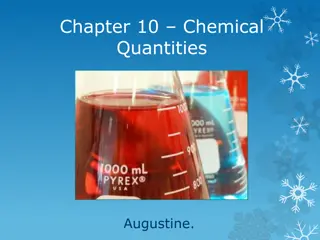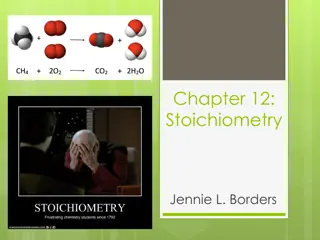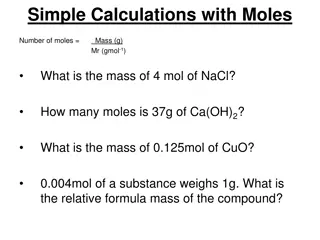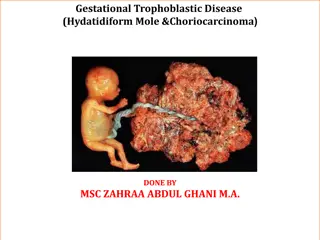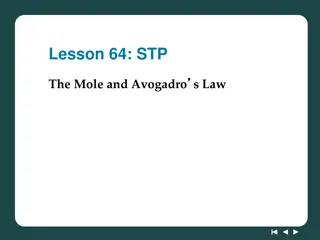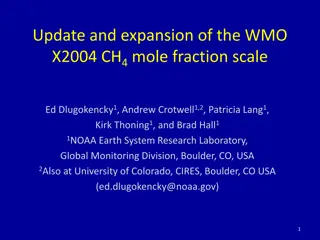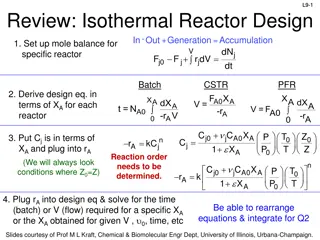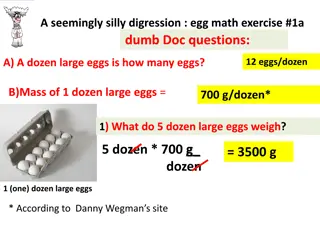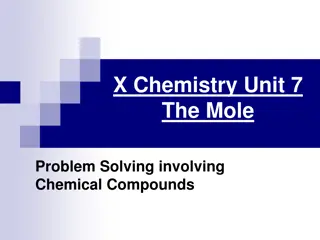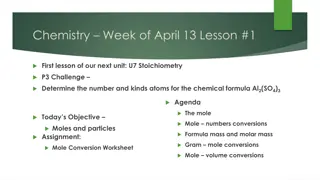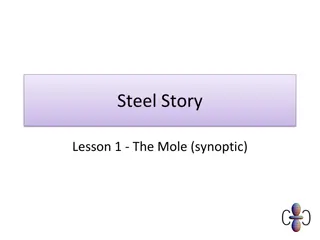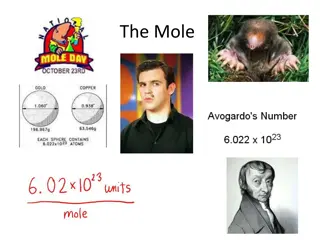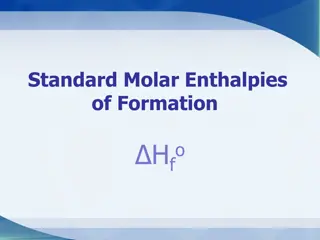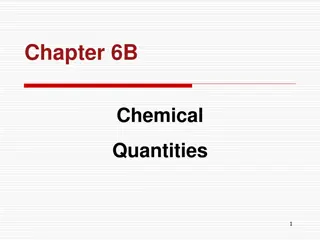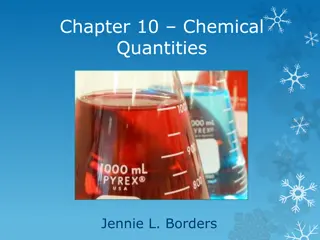
Mole: Comprehensive Tutorial Notes
Learn about the mole, the SI unit of amount of substance, Avogadro Constant, molar mass of elements, molecules, and compounds. Understand how to calculate molar mass and solve standard revision questions regarding moles.
Download Presentation

Please find below an Image/Link to download the presentation.
The content on the website is provided AS IS for your information and personal use only. It may not be sold, licensed, or shared on other websites without obtaining consent from the author. If you encounter any issues during the download, it is possible that the publisher has removed the file from their server.
You are allowed to download the files provided on this website for personal or commercial use, subject to the condition that they are used lawfully. All files are the property of their respective owners.
The content on the website is provided AS IS for your information and personal use only. It may not be sold, licensed, or shared on other websites without obtaining consent from the author.
E N D
Presentation Transcript
2012 The Mole A comprehensive tutorial notes Incorporating standard revision questions Wath Academic services Julius G Thungu jgthungu@gmail.com jgthungu@gmail.com 1
A. THE MOLE The mole is the SI unit of the amount of substance. The number of particles e.g. atoms, ions, molecules, electrons, cows, cars are all measured in terms of moles. The number of particles in one mole is called the Avogadro Constant. It is denoted L . The Avogadro Constant contain 6.023 x10 23particles. i.e. 1mole = 6.023 x10 23 particles = 6.023 x10 23 2 moles = 2 x 6.023 x10 23 particles = 1.205 x10 24 0.2 moles = 0.2 x 6.023 x10 23 particles = 1.205 x10 22 0.0065 moles = 0.0065 x 6.023 x10 23 particles = 3.914 x1021 jgthungu@gmail.com 2
The mass of one mole of a substance is called molar mass. The molar mass of: (i)an element has mass equal to relative atomic mass /RAM(in grams)of the element e.g. Molar mass of carbon(C)= relative atomic mass = 12.0g 6.023 x10 23 particles of carbon = 1 mole =12.0 g Molar mass of sodium(Na) = relative atomic mass = 23.0g 6.023 x10 23 particles of sodium = 1 mole =23.0 g Molar mass of Iron (Fe) = relative atomic mass = 56.0g 6.023 x10 23 particles of iron = 1 mole =56.0 g jgthungu@gmail.com 3
(ii)a molecule has mass equal to relative molecular mass /RMM (in grams)of the molecule. Relative molecular mass is the sum of the relative atomic masses of the elements making the molecule. e.g. Molar mass Oxygen molecule(O2) =relative molecular mass =(16.0x 2)g =32.0g 6.023 x10 23 particles of Oxygen molecule =1 mole = 32.0 g Molar mass chlorine molecule(Cl2) =relative molecular mass =(35.5x 2)g =71.0g 6.023 x10 23 particles of chlorine molecule = 1 mole =71.0 g Molar mass Nitrogen molecule(N2) =relative molecular mass =(14.0x 2)g =28.0g 6.023 x10 23 particles of Nitrogen molecule =1 mole =28.0 g jgthungu@gmail.com 4
(iii)a compound has mass equal to relative formular mass /RFM (in grams)of the molecule. Relative formular mass is the sum of the relative atomic masses of the elements making the compound. e.g. (i)Molar mass Water(H2O) = relative formular mass =[(1.0 x 2 ) + 16.0]g =18.0g 6.023 x10 23 particles of Water molecule = 1 mole = 18.0 g 6.023 x10 23 particles of Water molecule has: - 2 x 6.023 x10 23 particles of Hydrogen atoms -1 x 6.023 x10 23 particles of Oxygen atoms (ii)Molar mass sulphuric(VI)acid(H2SO4) = relative formular mass =[(1.0 x 2 ) + 32.0 + (16.0 x 4)]g =98.0g 6.023 x10 23 particles of sulphuric(VI)acid(H2SO4) = 1 mole = 98.0g 6.023 x10 23 particles of sulphuric(VI)acid(H2SO4) has: - 2 x 6.023 x10 23 particles of Hydrogen atoms -1 x 6.023 x10 23 particles of Sulphur atoms -4 x 6.023 x10 23 particles of Oxygen atoms jgthungu@gmail.com 5
(iii)Molar mass Na2CO3= relative formula mass =[(23.0 x 2 ) + 12.0 + (16.0 x 3)]g =106.0g 6.023 x10 23 particles of Na2CO3 = 1 mole = 106.0g 6.023 x10 23 particles of sodium carbonate(IV)(Na2CO3) has: - 2 x 6.023 x10 23 particles of Sodium atoms -1 x 6.023 x10 23 particles of Carbon atoms -3 x 6.023 x10 23 particles of Oxygen atoms (iv)Molar mass CaCO3= relative formula mass =[(40.0+ 12.0 + (16.0 x 3)]g =100.0g. 6.023 x10 23 particles of CaCO3 = 1 mole = 100.0g 6.023 x10 23 particles of Calcium carbonate(IV)(CaCO3) has: - 1 x 6.023 x10 23 particles of Calcium atoms -1 x 6.023 x10 23 particles of Carbon atoms -3 x 6.023 x10 23 particles of Oxygen atoms jgthungu@gmail.com 6
(v)Molar mass Water(H2O) = relative formular mass =[(2 x 1.0 )+ 16.0 ]g =18.0g 6.023 x10 23 particles of Water(H2O) = 1 mole = 18.0g 6.023 x10 23 particles of Water(H2O) has: - 2 x 6.023 x10 23 particles of Hydrogen atoms -2 x 6.023 x10 23 particles of Oxygen atoms (vi)Molar mass Nitric(V)acid(HNO3)= relative formular mass =[(2 x 1.0 )+ 14.0 + (3 x16.0) ]g =63.0g 6.023 x10 23 particles of HNO3 = 1 mole = 63.0g 6.023 x10 23 particles of nitric(V)acid(HNO3) has: - 1 x 6.023 x10 23 particles of Hydrogen atoms -1 x 6.023 x10 23 particles of Nitrogen atoms -3 x 6.023 x10 23 particles of Oxygen atoms jgthungu@gmail.com 7
Practice 1. Calculate the number of moles present in: (i)0.23 g of Sodium atoms Molar mass of Sodium atoms = 23g Moles = mass in grams = > 0.23g = 0.01moles/ Molar mass (ii) 0.23 g of Chlorine atoms Molar mass of Chlorine atoms = 35.5 g Moles = mass in grams = > 0.23g = 0.0065moles / Molar mass (iii) 0.23 g of Chlorine molecules Molar mass of Chlorine molecules =( 35.5 x 2) = 71.0 g Moles = mass in grams = > 0.23g = 0.0032moles / Molar mass 1.0x 10-2moles 23 35.5 6.5 x 10-3 moles 71 jgthungu@gmail.com 8
(iv) 0.23 g of dilute sulphuric(VI)acid Molar mass of H2SO4 = [(2 x 1) + 32 + (4 x16)] = 98.0g Moles = mass in grams = > 0.23g = 0.0023moles / Molar mass 98 2.3 x 10-3 moles (v) 0.23 g of sodium carbonate(IV) Molar mass of Na2CO3= [(2 x 23) + 12 + (3 x16)] = 106.0g Moles = mass in grams = > 0.23g = 0.0022moles / Molar mass 106 2.2 x 10-3 moles (vi) 0.23 g of sodium carbonate(IV)decahydrate Molar mass of Na2CO3.10H2 O= [(2 x 23) + 12 + (3 x16) + (10 x 1.0) + (10 x 16)] = 276.0g Moles = mass in grams = > 0.23g = 0.00083moles / Molar mass 276 8.3 x 10-4 moles jgthungu@gmail.com 9
2. Calculate the number of atoms present in:(Avogadros constant L = 6.0 x 10 23) (i) 0.23 g of dilute sulphuric (VI)acid Method I Molar mass of H2SO4 = [(2 x 1) + 32 + (4 x14)] = 98.0g Moles = mass in grams = > 0.23g = 0.0023moles / Molar mass 1 mole has 6.0 x 10 23 atoms 2.3 x 10-3moles has (2.3 x 10-3 x 6.0 x 10 23) = 1.38 x 10 21 Method II Molar mass of H2SO4 = [(2 x 1) + 32 + (4 x14)] = 98.0g 98.0g = 1 mole has 6.0 x 10 23 atoms 0.23 g therefore has (0.23 g x 6.0 x 10 23 )= 1.38 x 10 21 jgthungu@gmail.com 2.3 x 10-3 moles 98 1 98 10
(ii)0.23 g of sodium carbonate(IV)decahydrate Molar mass of Na2CO3.10H2 O= [(2 x 23) + 12 + (3 x16) + (10 x 1.0) + (10 x 16)] = 276.0g Method I Moles = mass in grams = > 0.23g = 0.00083moles / Molar mass 1 mole has 6.0 x 10 23 atoms 8.3 x 10-4 moles has (8.3 x 10-4 moles x 6.0 x 10 23) Method II 276.0g = 1 mole has 6.0 x 10 23 atoms 0.23 g therefore has (0.23 g x 6.0 x 10 23 ) jgthungu@gmail.com 276 8.3 x 10-4 moles 1 = 4.98 x 10 20atoms 276.0 = 4.98 x 10 20atoms 11
(iii)0.23 g of Oxygen gas Molar mass of O2 = (2 x16) = 32.0 g Method I Moles = mass in grams = > 0.23g = 0.00718moles / Molar mass 1 mole has 2 x 6.0 x 10 23 atoms in O2 7.18 x 10-3moles has (7.18 x 10-3moles x 2 x 6.0 x 10 23) = 8.616 x 10 21atoms 1 Method II 32.0g = 1 mole has 2 x 6.0 x 10 23 atoms in O2 0.23 g therefore has (0.23 g x 2 x 6.0 x 10 23 )= 8.616 x 10 21atoms 32.0 32 7.18 x 10-3 moles jgthungu@gmail.com 12
(iv)0.23 g of Carbon(IV)oxide gas Molar mass of CO2 = [12 + (2 x16)] = 44.0 g Method I Moles = mass in grams = > 0.23g = 0.00522moles / Molar mass 44 5.22 x 10-3 moles 1 mole has 3 x 6.0 x 10 23 atoms in CO2 7.18 x 10-3moles has: (5.22 x 10-3moles x 3 x 6.0 x 10 23) =9.396 x 10 21atoms 1 Method II 44.0g = 1 mole has 3 x 6.0 x 10 23 atoms in CO2 0.23 g therefore has: (0.23 g x 3 x 6.0 x 10 23 )= 9.409 x 10 21atoms 44.0 jgthungu@gmail.com 13
(b)Empirical and molecular formula The empirical formula of a compound is its simplest formula. It is the simplest whole number ratios in which atoms of elements combine to form the compound. It is mathematically the lowest common multiple (LCM) of the atoms of the elements in the compound Practically the empirical formula of a compound can be determined as in the following examples. To determine the empirical formula of copper oxide (a)Method 1:From copper to copper(II)oxide Procedure. jgthungu@gmail.com 14
Weigh a clean dry covered crucible(M1). Put two spatula full of copperpowder into the crucible. Weigh again (M2). Heat the crucible strongly for five minutes. Lift the lid, and swirl the crucible carefully using a pair of tong. Cover the crucible and continue heating for another five minutes. Remove the lid and stop heating. Allow the crucible to cool. When cool replace the lid and weigh the contents again (M3). jgthungu@gmail.com 15
Sample results Mass of crucible(M1) Mass of crucible + copper before heating(M2) Mass of crucible + copper after heating(M3) Questions 1. Calculate the mass of copper powder used. Mass of crucible + copper before heating(M2) = 18.4 Mass of crucible(M1) Mass of copper 2. Calculate the mass of Oxygen used to react with copper. Method I Mass of crucible + copper after heating(M3) = 19.1g Mass of crucible + copper before heating(M2) = - 18.4g Mass of Oxygen 15.6g 18.4 19.1 = - 15.6g 2.8 g = 0.7 g jgthungu@gmail.com 16
Method II Mass of crucible + copper after heating(M3) = 19.1g Mass of crucible Mass of copper(II)Oxide Mass of copper(II)Oxide Mass of copper Mass of Oxygen = 3.5 g = - 2.8 g = = - 15.6g = 3.5 g 0.7 g 3. Calculate the number of moles of: (i) copper used (Cu = 63.5) moles of copper = mass used => 2.8 = 0.0441moles Molar mass 63.5 (ii) Oxygen used (O = 16.0) moles of oxygen = mass used => 0.7 = 0.0441moles Molar mass 16.0 jgthungu@gmail.com 17
4. Determine the mole ratio of the reactants Moles of copper = 0.0441moles = 1 Moles of oxygen 0.0441moles 1 Mole ratio Cu: O = 1:1 5.What is the empirical, formula of copper oxide formed. CuO (copper(II)oxide 6. State and explain the observations made during the experiment. Observation Colour change from brown to black Explanation Copper powder is brown. On heating it reacts with oxygen from the air to form black copper(II)oxide => jgthungu@gmail.com 18
7. Explain why magnesium ribbon/shavings would be unsuitable in a similar experiment as the one above. Hot magnesium generates enough heat energy to react with both Oxygen and Nitrogen in the air forming a white solid mixture of Magnesuin oxide and magnesium nitride. This causes experimental mass errors. (b)Method 2:From copper(II)oxide to copper Procedure. Weigh a clean dry porcelain boat (M1). Put two spatula full of copper(II)oxide powder into the crucible. Reweigh the porcelain boat (M2). Put the porcelain boat in a glass tube and set up the apparatus as below; jgthungu@gmail.com 19
Determining empirical formula from copper(II)oxide to copper Copper(II)oxide Excess hydrogen burning HEAT Hydrogen /Laboratory gas / Ammonia gas/Carbon(II)Oxide gas from a generator jgthungu@gmail.com 20
Pass slowly(to prevent copper(II)oxide from being blown away)a stream of either dry Hydrogen /ammonia/laboratory gas/ carbon(II)oxide gas for about two minutes from a suitable generator. When all the in the apparatus set up is driven out ,heat the copper(II)oxide strongly for about five minutes until there is no further change. Stop heating. Continue passing the gases until the glass tube is cool. Turn off the gas generator. Carefully remove the porcelain boat form the combustion tube. Reweigh (M3). jgthungu@gmail.com 21
Sample results Mass of boat(M1) 15.6g Mass of boat before heating(M2) 19.1 Mass of boat after heating(M3) 18.4 Sample questions 1. Calculate the mass of copper(II)oxide used. Mass of boat before heating(M2) = 19.1 Mass of empty boat(M1) Mass of copper(II)Oxide = - 15.6g 3.5 g 2. Calculate the mass of (i) Oxygen. jgthungu@gmail.com 22
Mass of boat before heating(M2) Mass of boat after heating (M3) Mass of oxygen (ii)Copper Mass of copper(II)Oxide Mass of oxygen Mass of oxygen 3. Calculate the number of moles of: (i) Copper used (Cu = 63.5) = 19.1 = - 18.4g = 0.7 g = 3.5 g = 0.7 g = 2.8 g moles of copper = mass used => 2.8 = 0.0441moles Molar mass 63.5 (ii) Oxygen used (O = 16.0) moles of oxygen = mass used => 0.7 = 0.0441moles Molar mass 16.0 jgthungu@gmail.com 23
4. Determine the mole ratio of the reactants Moles of copper = 0.0441moles = 1 => Moles of oxygen 0.0441moles 1 5.What is the empirical, formula of copper oxide formed. CuO (copper(II)oxide 6. State and explain the observations made during the experiment. Observation Colour change from black to brown Explanation Copper(II)oxide powder is black. On heating it is reduced by a suitable reducing agent to brown copper metal. jgthungu@gmail.com 24
7. Explain why magnesium oxide would be unsuitable in a similar experiment as the one above. Magnesium is high in the reactivity series. None of the above reducing agents is strong enough to reduce the oxide to the metal. 8. Write the equation for the reaction that would take place when the reducing agent is: (i) Hydrogen CuO(s) + H2(g) -> Cu(s) (Black) (brown) (colourless liquid form on cooler parts ) (ii)Carbon(II)oxide CuO(s)+ CO (g) -> Cu(s) (Black) (brown) + H2O(l) + CO2(g) (colourless gas, form jgthungu@gmail.com white ppt with lime water ) 25
(iii)Ammonia 3CuO(s) +2NH3(g) -> 3Cu(s) + N2 (g) +3H2O(l) (Black) (brown) (colourless liquid form 9. Explain why the following is necessary during the above experiment; (i)A stream of dry hydrogen gas should be passed before heating copper (II) Oxide. Air combine with hydrogen in presence of heat causing an explosion (ii)A stream of dry hydrogen gas should be passed after heating copper (II) Oxide has been stopped. Hot metallic copper can be re-oxidized back to copper(II)oxide on cooler parts ) jgthungu@gmail.com 26
(iii) A stream of excess carbon(II)oxide gas should be ignited to burn Carbon(II)oxide is highly poisonous/toxic. On ignition it burns to form less toxic carbon(IV)oxide gas. 10. State two sources of error in this experiment. (i)All copper(II)oxide may not be reduced to copper. (ii)Some copper(II)oxide may be blown out the boat by the reducing agent. 4.Theoreticaly the empirical formula of a compound can be determined as in the following examples. (a) A oxide of copper contain 80% by mass of copper. Determine its empirical formula jgthungu@gmail.com 27
% of Oxygen = 100% - % of Copper => 100- 80 = 20% of Oxygen Element Copper Oxygen Symbol Cu O Moles present = % composition Molar mass 80 63.5 20 16 Divide by the smallest value 1.25 1.25 1.25 1.25 Mole ratios 1 1 Empirical formula is CuO jgthungu@gmail.com 28
(b)1.60g of an oxide of Magnesium contain 0.84g by mass of Magnesium. Determine its empirical formula (Mg = 24.0, 16.0) Mass of Oxygen = 1.60 0.84 => 0.56 g of Oxygen Element Magnesium Oxygen Symbol Mg O Moles present = % composition Molar mass Divide by the smallest value 0.84 24 0.35 0.35 1 0.56 16 0.35 0.35 1 Mole ratios Empirical formula is MgO jgthungu@gmail.com 29
(c)An oxide of Silicon contain 47% by mass of Silicon. What is its empirical formula(Si = 28.0, 16.0) Mass of Oxygen = 100 47 => 53% of Oxygen Element Silicon Oxygen Symbol Si O Moles present = % composition Divide by the smallest value 47 28 1.68 1.68 1 53 16 3.31 1.68 1.94 = 2 Molar mass Mole ratios Empirical formula is SiO2 jgthungu@gmail.com 30
(d)A compound contain 70% by mass of Iron and 30% Oxygen. What is its empirical formula(Fe = 56.0, 16.0) Mass of Oxygen = 100 47 => 53% of Oxygen Element Silicon Oxygen Symbol Si O Moles present = % composition Molar mass Divide by the smallest value 47 28 1.68 1.68 53 16 3.31 1.68 1.94 = 2 Mole ratios 1 Empirical formula is SiO2 jgthungu@gmail.com 31
4. The molecular formula is the actual number of each kind of atoms present in a molecule of a compound. The empirical formula of an ionic compound is the same as the chemical formula but for simple molecular structured compounds, the empirical formula may not be the same as the chemical formula. The molecular formula is a multiple of empirical formula . It is determined from the relationship: (i) n = Relative formular mass Relative empirical formula where n is a whole number. (ii) Relative empirical formula x n = Relative formula mass where n is a whole number. jgthungu@gmail.com 32
1. A hydrocarbon was found to contain 92.3% carbon and the remaining Hydrogen. If the molecular mass of the compound is 78, determine the molecular formula(C=12.0, H =1.0) Mass of Hydrogen = 100 92.3 => 7.7% of Oxygen Element Symbol Moles present = % composition Molar mass Divide by the smallest value Carbon C 92.3 12 7.7 7.7 1 Hydrogen H 7.7 1 7.7 7.7 1 Mole ratios Empirical formula is CH The molecular formular is thus determined : n = Relative formular mass Relative empirical formula 13 The molecular formula is (C H ) x 6 = C6H6 = 78 = 6 jgthungu@gmail.com 33
2. A compound of carbon, hydrogen and oxygen contain 54.55% carbon, 9.09% and remaining36.36% oxygen. If its relative molecular mass is 88, determine its molecular formula(C=12.0, H =1.0, O= 16.0) Element Symbol Moles present = % composition Molar mass Divide by the smallest value Carbon C 54.55 12 4.5458 2.2725 2 Hydrogen Oxygen H 9.09 1 9.09 2.2725 4 O 36.36 16 2.2725 2.2725 1 Mole ratios Empirical formula is C2H4O The molecular formular is thus determined : n = Relative formular mass Relative empirical formula = 88 = 2 44 The molecular formula is (C2H4O ) x 2 = C4H8O2. jgthungu@gmail.com 34
3.A hydrocarbon burns completely in excess air to form 5.28 g of carbon (IV) oxide and 2,16g of water. If the molecular mass of the hydrocarbon is 84, what is its molecular. Since a hydrocarbon is a compound containing Carbon and Hydrogen only. Then: Mass of carbon in CO2 = Mass of C in CO2 x mass of CO2 Molar mass of CO2 => 12 x 5.28 = 1.44g 44 Mass Hydrogen in H2O = Mass of C in H2Ox mass of H2O Molar mass of H2O => 2 x 2.16 = 0.24g 18 jgthungu@gmail.com 35
Element Symbol Moles present = % composition Molar mass Divide by the smallest value Carbon C 1.44g 12 0.12 0.12 1 Hydrogen H 0.24g 1 0.24 0.12 2 Mole ratios Empirical formula is CH2 The molecular formular is thus determined : n = Relative formular mass = 84 = 6 Relative empirical formula 14 The molecular formula is (CH2 ) x 6 = C6H12. jgthungu@gmail.com 36
(b)Molar solutions A molar solution is one whose concentration is known. The SI unit of concentration is Molarity denoted M. Molarity may be defined as the number of moles of solute present in one cubic decimeter of solution. One cubic decimeter is equal to one litre and also equal to 1000cm3. The higher the molarity the higher the concentration and the higher/more solute has been dissolved in the solvent to make one cubic decimeter/ litre/1000cm3 solution. Examples 2M sodium hydroxide means 2 moles of sodium hydroxide solute is dissolved in enough water to make one cubic decimeter/ litre/1000cm3 uniform solution mixture of sodium hydroxide and water. 0.02M sodium hydroxide means 0.02 moles of sodium hydroxide solute is dissolved in enough water to make one cubic decimeter/ litre/1000cm3 uniform solution mixture of sodium hydroxide and water. 2M is more concentratedthan 0.02M . jgthungu@gmail.com 37
Preparation of molar solution Procedure Weigh accurately 4.0 g of sodium hydroxide pellets into a 250cm3 volumetric flask. Using a wash bottle add about 200cm3 of distilled water. Stopper the flask. Shake vigorously for three minutes. Remove the stopper for a second then continue to shake for about another two minutes until all the solid has dissolved. Add more water slowly upto exactly the 250 cm3 mark. Sample questions 1.Calculate the number of moles of sodium hydroxide pellets present in: (i) 4.0 g. jgthungu@gmail.com 38
Molar mass of NaOH = (23 + 16 + 1) = 40g Moles = Mass => 4.0 = 0.1 / 1.0 x 10 -1 moles Molar mass 40 (ii) 250 cm3 solution in the volumetric flask. Moles in 250 cm3 = 0.1 / 1.0 x 10 -1 moles (iii) one decimeter of solution Method 1 Moles in decimeters = Molarity = Moles x 1000cm3 /1dm3 => 1.0 x 10 -1 moles x 1000cm3 = 250cm3 = 0.4 M / 0.4 molesdm-3 Volume of solution jgthungu@gmail.com 39
Method 2 250cm3 solution contain 1.0 x 10 -1 moles 1000cm3 solution = Molarity contain 1000 x 1.0 x 10 -1 moles 250 cm3 = 0.4 M / 0.4 molesdm-3 Theoretical sample practice 1. Calculate the molarity of a solution containing: (i) 4.0 g sodium hydroxide dissolved in 500cm3 solution Molar mass of NaOH = (23 + 16 + 1) = 40g Moles = Mass => 4.0 Molar mass 40 Method 1 = 0.1 / 1.0 x 10 -1 moles jgthungu@gmail.com 40
Moles in decimeters = Molarity = Moles x 1000cm3/1dm3 => 1.0 x 10 -1 moles x 1000cm3 500cm3 = 0.2 M / 0.2 molesdm-3 Volume of solution Method 2 500 cm3 solution contain 1.0 x 10 -1 moles 1000cm3 solution = Molarity contain 1000 x 1.0 x 10 -1 moles 500 cm3 = 0.2 M / 0.2 molesdm-3 (ii) 5.3 g anhydrous sodium carbonate dissolved in 50cm3 solution jgthungu@gmail.com 41
Molar mass of Na2CO3 = (23 x 2 + 12 + 16 x 3) = 106 g Moles = Mass => 5.3 = 0.05 / 5. 0 x 10-2moles Molar mass 106 Method 1 Moles in decimeters = Molarity = Moles x1000cm3/1dm3 => 1.0 moles x 1000cm3 = =1.0 M Method 2 50 cm3 solution contain 5.0 x 10 -2 moles 1000cm3 solution = Molarity contain 1000 x 5.0 x 10 -2 moles 50 cm3 = 1.0M / 1.0 molesdm-3 Volume of solution 50cm3 (iii) 5.3 g hydrated sodium carbonate decahydrate dissolved in 50cm3 solution jgthungu@gmail.com 42
Molar mass of Na2CO3.10H2O = (23 x 2 + 12 + 16 x 3 + 20 x 1 + 10 x 16) =286g Moles = Mass => 5.3 = 0.0185 / 1.85 x 10 -2moles Molar mass 286 Method 1 Moles in decimeters = Molarity = Moles x1000cm3/1dm3 => 1.85 x 10 -2 moles x 1000cm3 = = 0.37 M/0.37 molesdm-3 Method 2 50 cm3 solution contain 1.85 x 10 -2 moles 1000cm3 solution = Molarity contain 1000 x 1.85 x 10 -2 moles = 3.7 x 10-1 M / 3.7 x 10-1 molesdm-3 Volume of solution 50cm3 50 cm3 (iv) 7.1 g of anhydrous sodium sulphate(VI)was dissolved in 20.0 cm3 solution. Calculate the molarity of the solution. jgthungu@gmail.com 43
Method 1 Molar mass Na2SO4 = 142 g Moles dm-3 = Molarity = Mass 3550 = 2.5 M/ molesdm-3 Molar mass 142 Method 2 Molar mass Na2SO4 = 142 g Moles = Mass => 7.1 Molar mass 142 Method 2(a) Moles in decimeters = Molarity = Moles x 1000cm3/1dm3 => 5.0 x 10 -2 moles x 1000cm3 Method 2(b) 20.0cm3 solution ->7.1 g 1000cm3 solution -> 1000 x 71 = 3550 g dm-3 20 = 0.05 / 5.0 x 10 -2moles Volume of solution 20cm3 = 2.5 M/2.5 molesdm-3 jgthungu@gmail.com 44
20 cm3 solution contain 5.0 x 10 -2 moles 1000cm3 solution = Molarity contain 1000 x 5.0 x 10 -2 moles (iv) The density of sulphuric(VI) is 1.84gcm-3 Calculate the molarity of the acid. Method 1 1.0cm3 solution ->1.84 g 1000cm3 solution -> 1000 x 1.84 = 1840 g dm-3 1 Molar mass H2SO4 = 98 g Moles dm-3 = Molarity = Mass = 1840 Molar mass 98 = 2.5 M/2.5 molesdm-3 20 cm3 = 18.7755 M/ molesdm-3 jgthungu@gmail.com 45
Method 2 Molar mass H2SO4 = 98 g Moles = Mass => 1.84 = 0.0188 / 1.88 x 10 -2moles Molar mass 98 Method 2(a) Moles in decimeters = Molarity = Moles x 1000cm3/1dm3 => 1.88 x 10 -2 moles x 1000cm3 = 18.8M/18.8 molesdm-3 Method 2(b) 20 cm3 solution contain 1.88 x 10 -2 moles 1000cm3 solution = Molarity contain 1000 x 1.88 x 10 -2 moles 1.0 cm3 Volume of solution 1.0cm3 jgthungu@gmail.com 46 = 18.8M/18.8 molesdm-3
2. Calculate the mass of : (i) 25 cm3 of 0.2M sodium hydroxide solution(Na =23.0.O =16.0, H=1.0) Molar mass NaOH = 40g Moles in 25 cm3 = Molarity x volume 1000 => 0.2 x 25 = 0.005/5.0 x 10-3moles 1000 Mass of NaOH = Moles x molar mass => 5.0 x 10-3 x 40 = 0.2 g (ii) 20 cm3 of 0.625 M sulphuric(VI)acid (S =32.0.O =16.0, H=1.0) jgthungu@gmail.com 47
Molar mass H2SO4 = 98g Moles in 20 cm3 = Molarity x volume=> 0.625 x 20 = 1000 0.0125/1.25.0 x 10-3moles Mass of H2SO4 =Moles x molar mass => 5.0 x 10-3 x 40 = 0.2 g 1000 (iii) 1.0 cm3 of 2.5 M Nitric(V)acid (N =14.0.O =16.0, H=1.0) Molar mass HNO3 = 63 g Moles in 1 cm3 = Molarity x volume => 1000 2.5 x 1 Mass of HNO3 =Moles x molar mass => 2.5 x 10-3 x 40 = = 0.0025 / 2.5. x 10-3moles 0.1 g jgthungu@gmail.com 48
3. Calculate the volume required to dissolve : (a)(i) 0.25moles of sodium hydroxide solution to form a 0.8M solution Volume (in cm3) = moles x 1000 => 0.25 x 1000 Molarity 0.8 = 312.5cm3 (ii) 100cm3 was added to the sodium hydroxide solution above. Calculate the concentration of the solution. C1 x V1 = C2 x V2 where: C1 = molarity/concentration before diluting/adding water C2 = molarity/concentration after diluting/adding water V1 = volume before diluting/adding water V2 = volume after diluting/adding water => 0.8M x 312.5cm3 = C2 x (312.5 + 100) C2 = 0.8M x 312.5cm3 = 0.6061M 412.5 jgthungu@gmail.com 49
(b)(ii) 0.01M solution containing 0.01moles of sodium hydroxide solution . Volume (in cm3) = moles x 1000 => Molarity 0.01 x 1000 0.01 (ii) Determine the quantity of water which must be added to the sodium hydroxide solution above to form a 0.008M solution. C1 x V1 = C2 x V2 where: C1 = molarity/concentration before diluting/adding water C2 = molarity/concentration after diluting/adding water V1 = volume before diluting/adding water V2 = volume after diluting/adding water => 0.01M x 1000 cm3 = 0.008 x V2 V2 = 0.01M x 1000cm3 = 1250cm3 0.008 Volume added = 1250 - 1000 = 250cm3 = 1000 cm3 jgthungu@gmail.com 50



